Chapter: Health Management in Aquaculture: Parasitic diseases and pests
Life Cycle Patterns of Fish Parasites
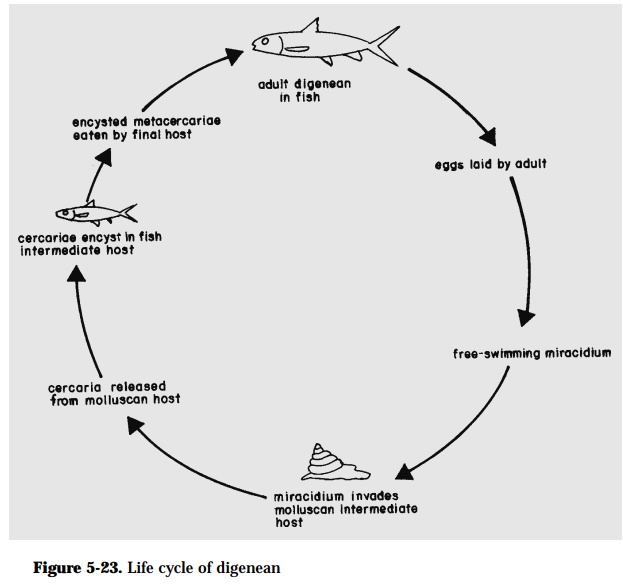
LIFE CYCLE PATTERNS OF FISH PARASITES
Parasites may have a direct life cycle, that is, only one host is needed to com-plete the parasite’s life cycle. Parasites may also have anindirect life cycle or they utilize more than one host to complete its life cycle. An “intermediatehost” is one where the larval stages of the parasite usually develop while the “final host” is where the adult stage develops. The final host often feed on theintermediate host. A parasite may also stay in another host, a “carrier orparatenic” host, but does not develop in this host. Some parasites are host-specific. This means that they can parasitize only one or a limited number of host species. Parasites that are tissue/ organ-specific parasitize only a particu-lar tissue or organ. An understanding of a parasite’s life cycle patterns is useful in disease prevention, since the parasite may be eliminated at the weakest point of its life cycle.
Most protozoan have a direct life cycle. At the infective stages, they are re-leased into the water to reinfect the same host or spread throughout the fish population (e.g. Ichthyophthirius) (Fig. 5-21).
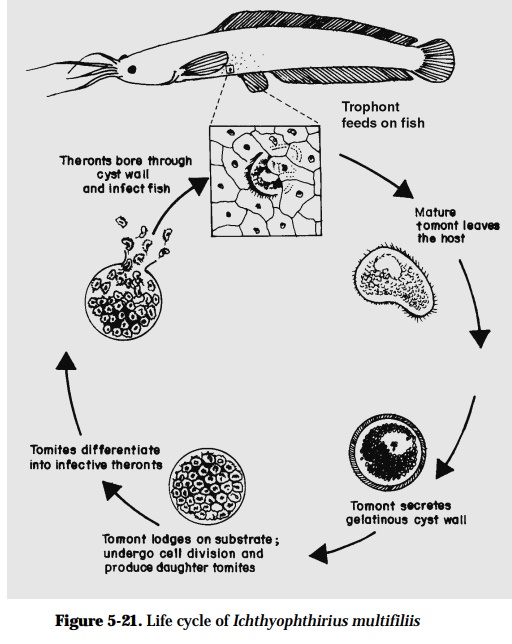
The blood parasites, e.g. Cryptobia, involve the leech, Piscicola, as the intermediate host, and are transmitted when the leech takes its blood meal.
Monogeneans have a direct life cycle. The free-swimming ciliated larvae (oncomiracidia) infect the host within a few hours. The parasites mi-grate to the final site of attachment and develop into adults (Fig. 5-22). An exception is the gyrodactylid, which bears live young (vivipa-rous) instead of laying eggs. In this case, transfer takes place among fish through physical contact.
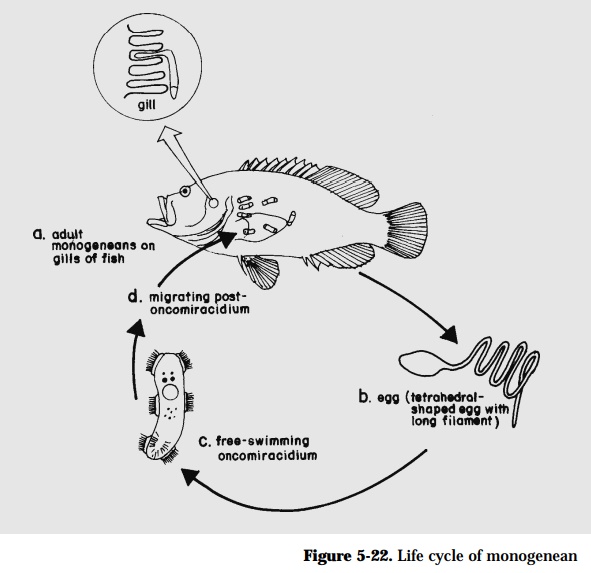
Digenean trematodes have an indirect life cycle. Adult parasites lay eggs (oviparous) and hatch as free-swimming larval stage(miracidium). They can survive only for a few hours during which it must find and infect the first intermediate host, often a gastropod or a bivalve mollusc. Cerca-riae develop and encyst into metacercariae in adifferent intermediate host that is eaten by the final host where the adults develop (Fig. 5-23).
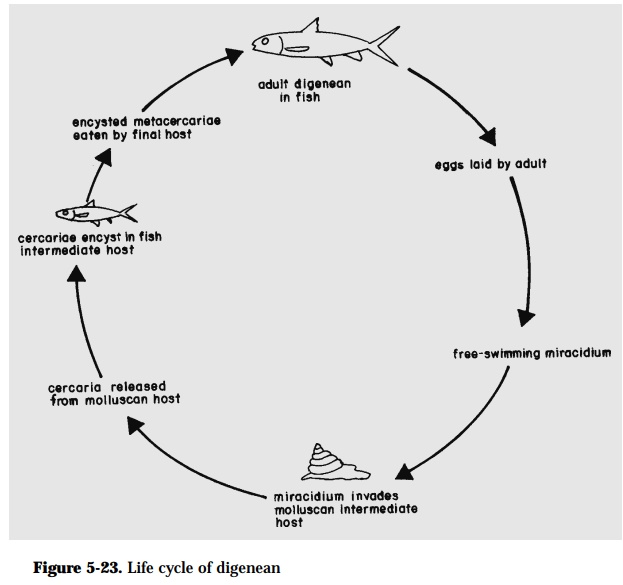
Cestodes are also oviparous and require one or more intermediate hosts. Eggs are passed in the feces and may or may not hatch in the water to release a free-swimming larva. The parasite de-velops further through various stages until fi-nally turning into a procercoid,which can infect a fish host.
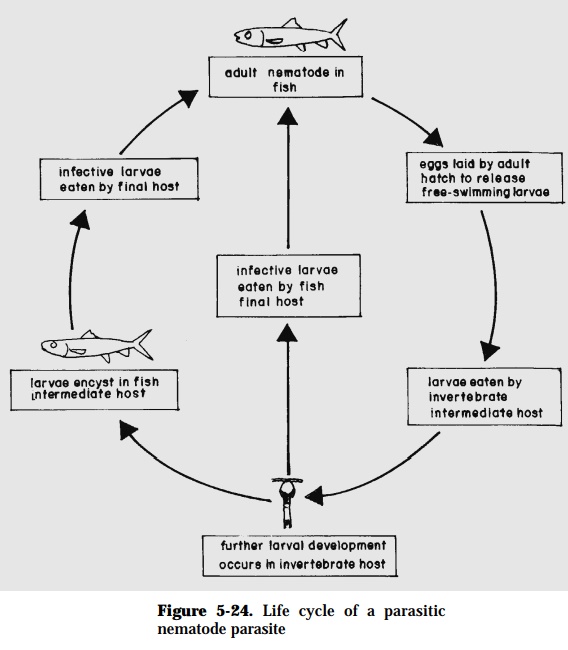
Nematodes are mostly oviparous. The intermediate host is usually an arthro-pod. The parasite may encyst in viscera and musculature of intermediate or paratenic hosts (Fig. 5-24). The females of orders Camallanoidea and Dracun-culoidae are viviparous and release di-rectly into the water.
Acanthocephalans also require an in-vertebrate host, usually an arthropod, to complete its life cycle.
The freshwater bivalve molluscs of the family Unionidae produce larvae (glochidia) which undergo an obliga-tory phase in the gills, fins or skin of the fish host. The parasitic phase may last for several months. The host tissue surround the parasite until it is shed from the fish, and grows into a free-liv-ing adult mollusc.
The mature female ergasilids are usually parasitic, while males are not. In caligids and lernaeids, some or all of the larval copepodid stages may be parasitic on an intermediate fish host or an individual of the final host species (Fig. 5-25). In other species, the males may be hyperparasitic on females.
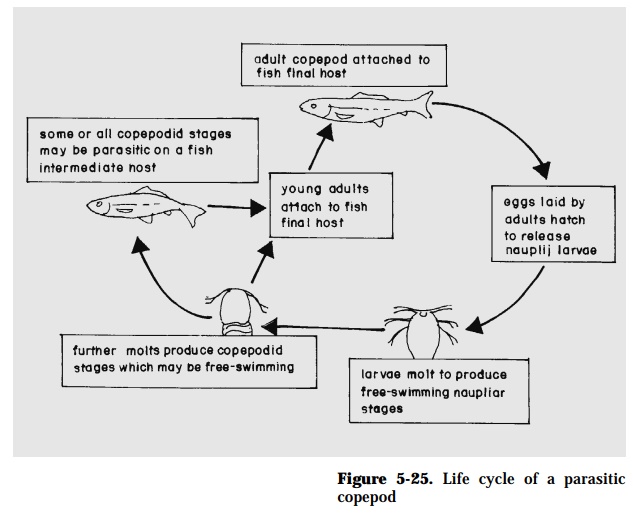
The parasitic isopods utilize an inter-mediate host, e.g., a copepod, in their life cycle. In grass shrimp, for example, the female isopods may be found in the gill chamber with the dwarf male among its pleopods. The tiny male fer-tilizes the ova and the resulting larva swims toward the light, attaches to the copepod intermediate host and devel-ops rapidly into another larval stage. The second stage larva molts and de-velops further into the larva (cryp-toniscus) infective for grass shrimps. Isopoda belonging to the “cyomothoid” type attach to fish early in life and start as a male before developing into a fe- male. Male-stage specimens cannot de- velop further in the presence of a ma
“Gnathiid” isopoda are parasitic only during the larval stage known as praniza. Leeches have a direct life cycle. Adults lay cocoons attached to a substrate. Young leeches hatch from cocoons and the life cycle is completed in more or less than a year’s time.
Related Topics